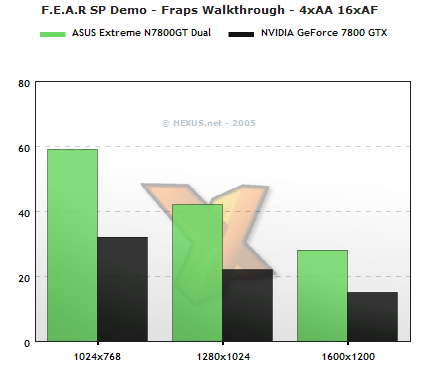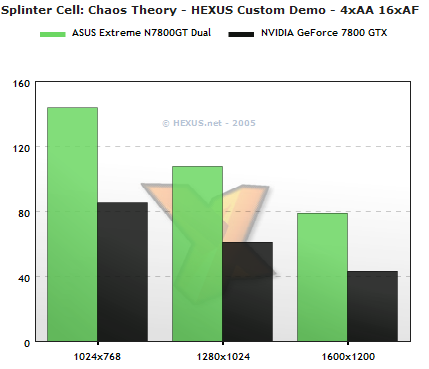The overriding sneak peak for me, and it's one I'm remiss in not being able to take part in for HEXUS, was PD's covert ops run into ASUS's Research and Development Lab to take a look at their EN6800 GT and Ultra single-board SLI products. Pairing two NV45 GPUs on a single PCB and have them work together to not only accelerate 3D graphics but also provide four display heads is no mean feat. Considering the PCB layout, power and bring-up challenges for such a product it's no surprise that it was to be a limited run product with barely a few thousand to hit retail.
What's sad is that the products never did make it that far, despite PD snapping dozens of them in ready to ship states after full testing by R&D. The EN6800GT and EN6800ULTRA products never were released to retail and ASUS canned the project at that stage. It makes getting your hands on a working sample akin to getting your hands on a working 3dfx Voodoo 5 6000, since the EN6800 products never even made it out of the building in significant numbers.
ASUS didn't can the idea of two GPUs on a single board in SLI mode, though. The recent release of NVIDIA G70 which powers the GeForce 7800 GTX and 7800 GT SKUs has given ASUS something new to work with. The G70 GPU, built on 110nm, is actually cooler and less power hungry than NV45, despite a large hike in transistor count and die area.
The challenge of therefore getting a pair onto a single PCB, powered properly and cooled well, is easier than doing the same thing with NV45. ASUS's knowledge in building same-board SLI with the EN6800s meant that bring-up of a G70-based product could be done relatively painlessly and certainly quicker than before.
And do so they did, resulting in the initial, and full retail I should happily add, introduction of the ASUS Extreme N7800GT Dual. PD hand delivered (no mean feat for him and his monstrous V6 Capri! ) one of the, if not the only, press samples available to UK press yesterday, and I've spent the last 24 hours or so testing and retesting the unique product to determine how it's likely to be received by the buying public.
The limited run of 2000 boards - each individually numbered as befits a bespoke, tailored product for the well-heeled - have many facets to talk about and discuss. We'll do so in full very soon, but first a HEXUS.pipeline preview of this cooler-than-cool graphics product that breaks the rules.
The board itself
We'll offer up the usual HEXUS board exam in the full HEXUS.review but a pipeline without a cursory glance at appearance is a pipeline with no attached cojones. With the Extreme N7800GT Dual, tener cojones is paramount.The first thing to notice is its size and in particular the height. See the backplane on the left with DVI outputs? You can see the black cable for power that snakes around the top of the board and pops out on the right and where that cable enters the backplane is the maximum height for any add-in board that meets the ATX specification. Consider something like the recent ATI Radeon X1800 XT which is no small reference board and measures around 230mm wide by 110mm high. The EN7800GT Dual is 245mm wide and 145mm high, making it nearly a third taller than a board that meets the ATX spec, like the X1800 XT, and nearly 2cm wider.
A big bugger I think you'll agree, and one that won't readily fit in a range of ATX chassis models. The power connector, loose on shipping, needs to be bent round and fed into the regular 6-pin power connector so that the feed from the supplied external power supply can make it into the board.
A closer look at the cooler shows it's a single fan model that pulls air in, moving airflow across the massive skived aluminium heatsink that cools both GPUs and all the memory modules actively. The cooler is adorned by the individually numbered covering plates that give the card a distinct appearance that's not to be mistaken for anything else. Ours is numbered 34 in the limited edition run of 2000 boards and is clearly marked as a press sample to boot.
The backplane space shows clearly what DVI port is the primary one and you can see the VIVO port for video in and out, the power supply connector and the empty backplane space for two DSUB analogue VGA ports that are supplied in the box but not fitted, which give the EN7800GT Dual four display ability. That ability is only to be had in non-SLI mode for the time being however, and ASUS leave it up to you to explore the analogue outputs yourself.
I'll leave proper talk on the noise that the card makes when doing various things, but suffice to say it's not as loud as the size hints at.
Performance
To round off this HEXUS.pipeline, two benchmark results to whet your appetite before the full analysis shows up.
Clocked at 430/600 out of the box, the Extreme N7800GT Dual in SLI mode has fun smacking a single GeForce 7800 GTX around.

In Splinter Cell: Chaos Theory, the gains are similar. 1600x1200 4xAA 16xAF becomes almost Vsync-able with no dips under 60fps on my LCD monitor, which the current GeForce 7800 GTX that I run certainly can't manage.
Initial Summary
I woke up this morning forgetting that the ASUS Extreme N7800GT Dual was in my office for testing. Climbing to the top of the stairs I looked into the room and saw the card on the bench, sleeping after a hard night's testing, and I laughed like a sectioned loony. The sheer size of the thing is cause for a giggle or ten every time you see it in action, especially shoehorned into a bemused chassis.Performance is nearly exactly where a pair of 430/600 clocked GTs is in 'regular' SLI, as expected, and apart from some driver weirdness at the start of the evaluation it tested fine and without any issue.
The size of the thing, the mainboards it'll work in and its price and availability are what define the Extreme N7800GT Dual and that's what we'll talk about in full in the complete HEXUS.review. Gigabyte started it all with the 3D1 and ASUS, while following, certainly feel as if single-board SLI is something worth bringing their customers.
Now to secure a working EN6800ULTRA for my collection of rare 3D hardware :grin:
















